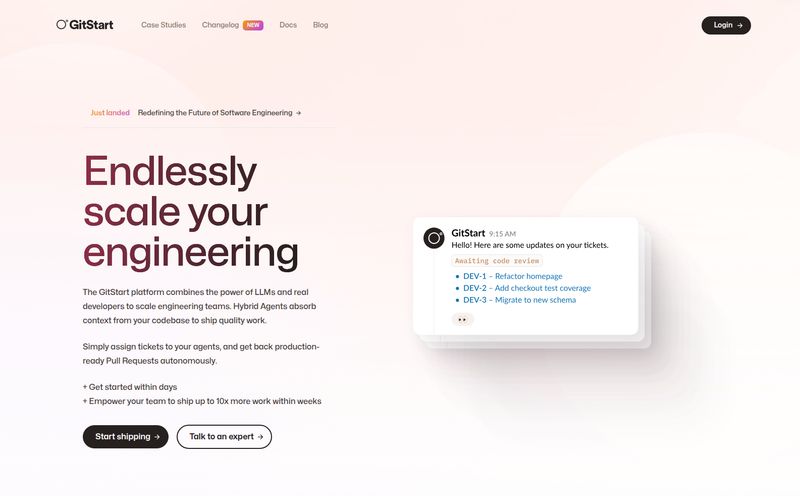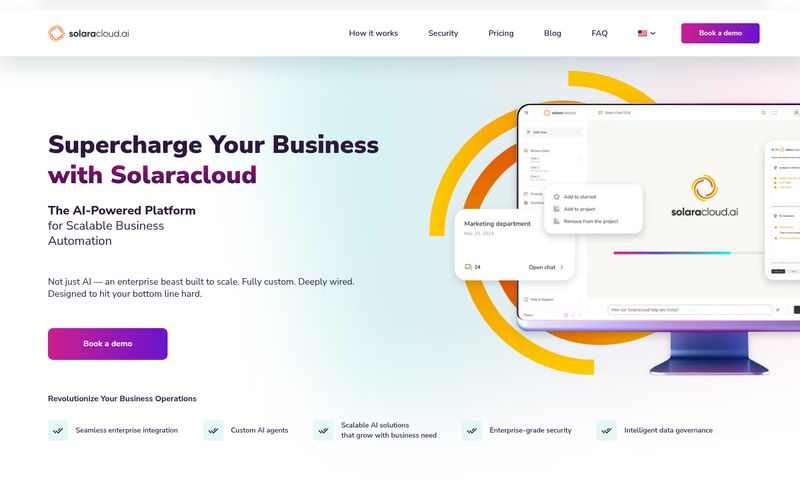For the past couple of years, the world of software development has been absolutely buzzing—or maybe swarming—with AI. It started with GitHub Copilot, which felt like magic. Suddenly, you had this ghostly pair programmer whispering suggestions in your ear. It was cool. It was helpful. But it also felt a bit... bolted on. Like adding a fancy GPS to a 1998 Toyota Corolla. It works, but it’s not part of the car’s soul.
I’ve been in the SEO and dev space for a long time, and I’ve seen trends come and go. But this AI thing is different. It's sticking around. And now, we're starting to see the next evolution. We're moving beyond simple plugins and into environments built from the ground up with AI at their core. That’s the promise of Windsurf, the new AI-native IDE from the folks at Codeium.
I've been keeping an eye on the Codeium team. With over a million developers using their tools, they obviously know a thing or two about what we want. So when they announced an entire IDE, my interest was piqued. Is this just another shiny object, or is it a genuine shift in how we’re going to be building things? I decided to take a closer look.
So, What Exactly is Windsurf?
Calling Windsurf just another IDE is missing the point. It’s designed around a concept they call “AI collaboration.” It’s not just there to autocomplete a line of code you were already thinking of writing. The goal is to create an environment that actively helps you stay in that precious, elusive state of flow. You know the one—where time melts away, and the code just... happens.
Think about it this way. Your current IDE with an AI plugin is reactive. You type something, it reacts. Windsurf aims to be proactive. It’s designed to anticipate what you need, understand the broader context of your project, and help you solve problems before they become frustrating roadblocks. It's less like a parrot on your shoulder and more like a seasoned co-pilot who’s already checking the flight plan, monitoring the instruments, and suggesting a better route around the storm ahead.
This isn't just about writing code faster. It's about reducing the mental friction that comes from switching contexts, looking up documentation, or debugging tedious errors. It's about keeping your brain focused on the big picture, on the actual architecture and logic, while the AI handles some of the grunt work.
The Features That Actually Matter
Okay, marketing speak is nice, but what does it actually do? I dug into the feature set, and a few things really stood out from the typical AI fare.
Meet Cascade, Your AI Agent
This is the star of the show. Windsurf introduces an agent named Cascade. The documentation says it “codes, fixes, and thinks.” From what I've seen, it's a system that can take on more complex tasks than a simple prompt-and-response chat. It seems to be able to chain thoughts and actions together, making it far more capable of handling multi-step problems. For example, instead of asking it to “write a function that does X,” you might be able to give it a higher-level goal, and it will figure out the steps, write the code, and even suggest how to fix it if things go wrong.
This is the kind of leap I’ve been waiting for. It’s the difference between asking for directions and having someone who can actually drive the car for a bit while you check the map. It's a fundamental change in the human-AI interaction model within the coding process.

Visit Windsurf
Windsurf Tab and Contextual Awareness
We’ve all been there. Your AI helper suggests something completely out of left field because it has no idea what you just copied to your clipboard or what command you ran in the terminal two seconds ago. Windsurf Tab tries to solve this. It ingests a much wider range of context—your command history, your clipboard actions, the overall state of your project—to give suggestions that are genuinely, well, smarter. This context is everything. Better context means more relevant suggestions, which means less time deleting nonsense code and more time making progress.
A Truly Integrated Workflow
One of the biggest productivity killers for me is context switching. Jumping from my editor to a terminal, then to a browser for documentation, then to a testing framework... it shatters my concentration. Windsurf is built to let you build, iterate, and ship all within one unified workflow. By integrating these processes, it keeps you in a single environment, which, in theory, should help maintain that flow state we talked about earlier. It's a simple idea, but one that could have a massive impact on daily productivity.
How Much Does This AI Partner Cost? A Look at Windsurf Pricing
This is always the big question, right? A tool can promise the world, but if it costs a fortune, it's a non-starter for most of us. Thankfully, the Windsurf pricing seems pretty reasonable and well-structured for different kinds of users.
| Plan | Price | Best For |
|---|---|---|
| Free | $0 / user / month | Individuals and hobbyists getting started. |
| Pro | $15 / user / month | Professional developers who need more power and credits. |
| Teams | $30 / user / month | Small to medium teams needing collaboration and admin tools. |
| Enterprise | $60 / user / month (or custom) | Large organizations with strict security and support needs. |
The Free tier is surprisingly generous, giving you enough to get a real feel for the platform. For professionals, the Pro plan at $15 a month is very competitive, especially if it delivers on its productivity promises. For companies, the Teams and Enterprise plans add the kind of admin, security, and even self-hosting options that are absolutely necessary. I like that they've thought through the entire spectrum of potential users.
The Good, The Bad, and The AI-Powered Reality
No tool is perfect, and it’s important to look at Windsurf with a critical eye. It's not magic, it’s a tool. And like any tool, it has its strengths and potential pitfalls.
On the plus side, the potential for a massive productivity boost is undeniable. I remember a project a few years back where we spent the first two weeks just getting the new hires up to speed on our bizarre, convoluted codebase. A tool like Windsurf could slash that onboarding time. It can help enforce coding standards without a senior dev having to micromanage every pull request. That alone is worth its weight in gold for team leads. It streamlines the whole workflow, and that is definitly a huge win.
Now, for the “be careful” part. There’s always the argument that these tools can become a crutch. Will junior developers learn to solve problems on their own, or will they just learn how to ask an AI for the answer? It’s a valid concern. My take? It’s like giving a mathematician a calculator. It doesn’t stop them from understanding math; it just frees them up from the tedious arithmetic to focus on higher-level theories. We need to teach people how to use the tool, not just let them use it blindly.
There's also the learning curve. Adopting a whole new IDE is a big commitment. It’s not like installing a VS Code extension. It requires changing habits and workflows, which can be disruptive at first. And finally, security is always on my mind. When you're feeding your proprietary code into a third-party tool, you need to be confident about how that data is handled. The Enterprise plan’s self-hosting option seems to be a direct answer to this concern, which is a smart move by the Codeium team.
Who Is Windsurf Really For?
After looking it all over, I think the audience for Windsurf is pretty clear.
- Individual Developers & Freelancers: If you live and breathe code and are always looking for an edge, the Pro plan is almost a no-brainer to try. The time saved could easily pay for the subscription fee many times over.
- Startups & Mid-Sized Teams: This might be the sweet spot. The Teams plan offers the collaboration and standardization features that growing teams desperately need, without the massive overhead of some enterprise solutions.
- Large Enterprises: For big companies, the appeal is all about security, compliance, and control. The ability to self-host the AI models and manage access centrally makes this a viable option where other cloud-based AI tools might be forbidden.
Ultimately, Windsurf feels like a confident step into the future of development. It’s not just iterating on the current AI tools; it's trying to build a new foundation entirely. It won't be for everyone—some people will always prefer their tried-and-true, manually configured setups. But for those of us who are willing to embrace the change, Windsurf looks like one of the most interesting and promising platforms to emerge in a long time. It feels less like a tool and more like a new partner.
Frequently Asked Questions about Windsurf
- What's the difference between Windsurf and Codeium?
- Codeium is primarily an AI toolkit—a code completion tool that works as an extension in many existing IDEs. Windsurf is a complete, standalone Integrated Development Environment (IDE) built by the Codeium team, with AI agents and collaboration features at its core.
- Can I use Windsurf with my existing tools?
- Windsurf is designed as an all-in-one environment, but it does offer MCP (Modular Code Provider) support for custom tool integration. The Cascade agent is also available separately for JetBrains IDEs, so you can get some of its power in your existing setup.
- Is there a free version of Windsurf?
- Yes, there is a Free plan that includes a 2-week trial of the Pro features and a monthly allowance of 200 AI credits, making it easy to try out the platform without any commitment.
- What happens if I run out of AI credits on my plan?
- On the paid plans like Pro and Teams, you have the option to purchase additional credits. For the Free plan, you would need to wait until the next monthly cycle for your credits to refresh, or upgrade to a higher tier.
- Is Windsurf secure for enterprise use?
- Security seems to be a major consideration. The Enterprise plan offers advanced security features, access controls, and even a self-hosting option, which allows a company to run Windsurf's models on their own infrastructure for maximum data privacy and control.
Reference and Sources
For more detailed information, you can visit the official sources directly:



